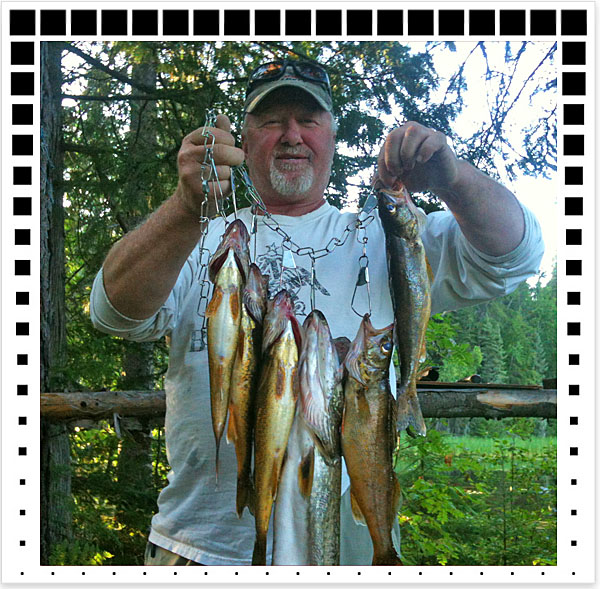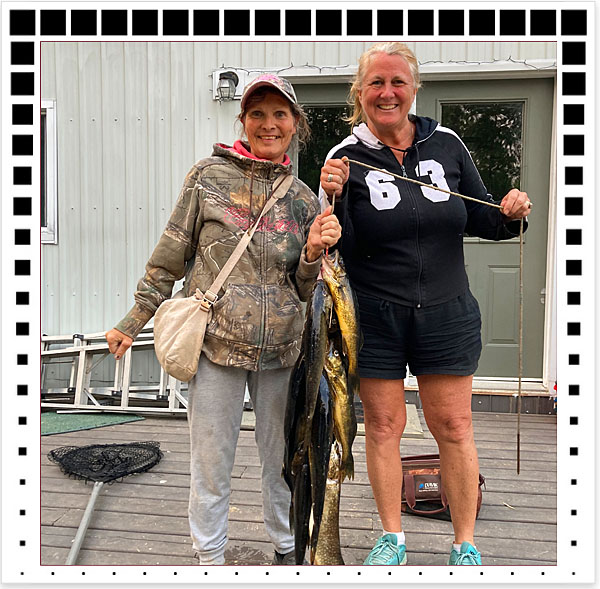



Biscotasing Lake is a big lake and produces big fish. It has a diverse rocky Canadian Shield structure with many weedy bays, island, shoals, points, narrows and feeder streams. The main water source is the Spanish River, which runs in and out of the lake and constantly refreshing the lake with oxygen and nutrients.
Walleye is the dominant species in the lake and there is a high population. It's also easier to fish because the water has that tea stain color, also known as Walleye Wine, so most of the Walleyes don't go super deep in the summer.
Walleye are most common in the 15" to 18" range. 20% of the Walleyes you catch will be in the 18' to 24" range. Biscotasing Lake is a huge lake with a diverse structure and a rich forage base. As a result Walleyes can get huge. There is a good chance at catching a bigger walleye between 5lbs. and 8lbs.. Once in a while fish over 10 pounds get caught and released. The big Walleyes are all female and tend to stay a lot deeper than the smaller males so if you target big fish you will catch less.
How many Walleyes you will catch in a day is a tricky question because there are so many factors involved. Wind, level of fishing skills, atmospheric pressure, light penetration, knowledge of the lake and water temperature are all key factors. An angler with years of experience on the lake and knowing where all the hot spots are could catch 50 walleyes in a day or more. If you are new to the lake you cannot expect that kind of success but there is always a chance that you come across a big school.
Typically if you are new to lake the best thing to do is troll along the shore or outside of the weedlines with a worm harness. Walleyes always follow the wind so fish the shoreline where the waves are crashing. When you catch a fish there is a good chance there are more in the same spot. That's when you can stop the boat and start jigging or casting crank baits. If you keep trolling back and forth over the same spot the fish will get spooked. Fishing these areas should produce 5 to 10 fish per day or more. If you have perfect conditions; 10mph west wind, mix of sun and clouds or overcast, you may catch a lot more. If the overcast conditions are caused by a low pressure system then you have to fish deeper or present a much slower bait like a minnow.
 Some areas of the lake have a darker tea stain than other parts. If you are in a stained area, which is usually back in bays, you need to use more visible colors such as white, yellow, neon green or silver. You don't want to use orange or red unless you use a steel leader because the pike will go after your lure. If fishing clearer water, which is usually areas facing the open lake, you can use darker colors like dark purple, dark blue or black.
Some areas of the lake have a darker tea stain than other parts. If you are in a stained area, which is usually back in bays, you need to use more visible colors such as white, yellow, neon green or silver. You don't want to use orange or red unless you use a steel leader because the pike will go after your lure. If fishing clearer water, which is usually areas facing the open lake, you can use darker colors like dark purple, dark blue or black.
In the spring the Walleyes will be shallow in 2' to 10' of water. By late spring they will be in 10' to 15' of water. In the summer warm surface water washes up on shore so the fish will go deeper and away from shore. Walleyes up to 24" will be in the 20' to 30' depth or may head out into open water and stay suspended where the water is cooler. All sizes of fish will move into shallow water in the evening to feed and then head out to deeper water at daybreak.
Targeting Trophy Walleye:
A few years ago the Ministry of Natural Resources used a submersible ROV to study the underwater geography of a handful of lakes in Northern Ontario. What they found on bottom astonished them. The floor of some of the lakes were littered with big fat trophy Walleyes all sitting on bottom. The one conservation officer was quoted as saying it looked like a pig farm. If you want to target a trophy; the best thing to do is back-troll as slow as possible and use a worm harness. To get your bait down to the bottom you can use a bottom bouncing rig such as a 3-way swivel or a Lindy rig. You can also get deep with Down Deep Husky Jerks or Cotton Cordell Big O's but generally the big females sitting on the bottom are not aggressive enough for these types of lures. If all else fails try drifting with minnows and literally drag the minnow along the bottom.